
 Author: Geoffrey Hamm, Sr. Automation Advisor
Author: Geoffrey Hamm, Sr. Automation Advisor
It starts with a map.
In 1983, Clark Griswold (all-American dad and fictional character) loaded up his family in a tragically unhip station wagon, heading west.
Destination: Wally World, “America’s Favorite Family Fun Park.”
Using the advanced computer simulations of the day, Clark was able to plot an optimized course – getting the maximum amount of fun time at Wally World without missing any of the “good stuff along the way.”

For those unfamiliar few who haven’t seen National Lampoon’s Vacation, their trip was… ill-fated. Riddled with setbacks but, eventually, they made it. In fact, given the comically high volume of setbacks, it is probably fair to say the only reason they made it was due to Clark’s preparedness and tenacity. Even in the face of extreme adversity, leaning into tried-and-true processes can minimize bad outcomes (i.e., future-proofing).
 When tasked with process improvement and digital transformation, it’s easy to feel overburdened.
When tasked with process improvement and digital transformation, it’s easy to feel overburdened.
How do we plan for something like that?
What are the right steps (and in what order)?
Are we focusing on the right things?
How do we avoid setbacks?
… It’s normal to feel overburdened.
We know the steps to help you build a successful process improvement and digital transformation practice. As a process company (literally, in the name), we have a process for process improvement – a process improvement process, if you will.
If you follow these steps, take it one mile at a time, keeping your eyes on the road – not on Christie Brinkley in the Ferrari 308 GTS (another Vacation reference) – we can help you get to where you need to be.
It all starts with a map; however, a map without a destination is fairly useless.
American politician Henry Kissinger once said, “if you do not know where you are going, every road will get you nowhere.”
Choosing a destination within digital transformation can be a real challenge. We’d all like to be better, faster, smarter, but… Better how? How much faster? Smarter in what way?
 Over the years (and hundreds of successful projects later), Salient Process has refined a North Star exercise to help our clients identify that destination much quicker and with greater confidence.
Over the years (and hundreds of successful projects later), Salient Process has refined a North Star exercise to help our clients identify that destination much quicker and with greater confidence.
The outcome of this exercise is a destination, and a means to determine that we have successfully arrived there. If I follow a map to the Grand Canyon and don’t see a massive hole in the ground when I get there, it might be time for a new map. The North Star exercise gives us a destination and establishes our unique success criteria (The Grand Canyon of metrics).
Our CEO Brian French wrote a great article on this North Star exercise.
Now that we know where we want to be and what it should look like when we get there, we can plot our course. We can now begin mapping our processes.
 In this phase, it is important to focus on the way things actually work, not the way we wish they worked (we’ll get to that later). We often refer to this as “current state” mapping aka your “As-Is”. In the first step, we determined where we’re going; now, we’re determining where we’re starting from (equally important).
In this phase, it is important to focus on the way things actually work, not the way we wish they worked (we’ll get to that later). We often refer to this as “current state” mapping aka your “As-Is”. In the first step, we determined where we’re going; now, we’re determining where we’re starting from (equally important).
Have you ever looked at a mall directory that didn’t have a “You Are Here” symbol? Fairly useless.
Sometimes this step can feel like we’re just drawing pretty process pictures, but it’s much more than that: we’re collecting data (data which will be used in later steps).
Using IBM Blueworks Live, we can map processes with ease. So much ease, in fact, that we can offer team members with absolutely no process experience a seat at the table. That being said, if you or your team members don’t have the time to commit to this pursuit, Salient can provide analysts to operate as an extension of your team
As mentioned previously, the biggest output of the process mapping exercise is data.
“‘Data is the new oil’ – Clive Humby” – Mark Cuban
The unabridged version of this quote originally by Clive Humby, since echoed by many, is as follows:
“Data is the new oil. It’s valuable, but if unrefined, it cannot really be used. It has to be changed into gas, plastic, chemicals, etc… to create a valuable entity that drives profitable activity; so must data be broken down, analyzed for it to have value.”
The data gathered in the previous step is only worth as much as our ability to consume it. If you buy a Ferrari and don’t drive it, why did you even buy it? You should drive it… and you should let me drive it too.
Automation Compass by Salient Process lets you “drive” your processes.
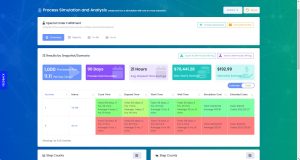 Automation Compass ingests your Blueworks Live maps, allowing you to run simulations against them – identifying gaps, bottlenecks, and waste.
Automation Compass ingests your Blueworks Live maps, allowing you to run simulations against them – identifying gaps, bottlenecks, and waste.
From here, we can begin “future state” mapping aka your “To-Be”.
We can make changes to our current state maps and rerun the simulations to assess the impact of the proposed changes:
All of these questions (and many more) can be answered using Automation Compass.
»Start your Automation Compass Journey Today!
We’ve come a long way since the “Trip Tic.”
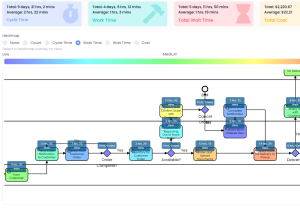 And, if you desire a more hands-off approach, Automation Compass can programmatically identify opportunities on your behalf. Using a proprietary algorithm powered by IBM Watson, Automation Compass can automatically uncover potential areas of business automation and show us how they align to specific capabilities.
And, if you desire a more hands-off approach, Automation Compass can programmatically identify opportunities on your behalf. Using a proprietary algorithm powered by IBM Watson, Automation Compass can automatically uncover potential areas of business automation and show us how they align to specific capabilities.
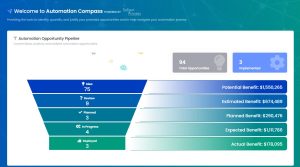 All opportunities we identify (or that are identified for us) can then be added to an opportunity pipeline within Automation Compass, allowing us to build and manage a backlog of improvement areas.
All opportunities we identify (or that are identified for us) can then be added to an opportunity pipeline within Automation Compass, allowing us to build and manage a backlog of improvement areas.
Commenting on the incessant inquiries into his writing process, Stephen King once said, “I invariably answer ‘one word at a time.”
At this juncture, we presumably have a list of process improvement opportunities. We have to choose which opportunity to tackle first.
Sometimes this decision is made based on less quantitative criteria (i.e., focus on a certain business unit or higher-level strategic initiatives), but most often, it comes down to the business case and the anticipated return on the investment (ROI). Coming out of the last step, we should have a pretty good idea of how much time and/or money the proposed changes might save us. With that information in hand (as well as a working estimate of the implementation cost), calculating the ROI is rudimentary.
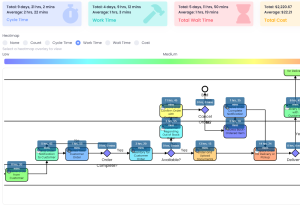 The icing on the cake – you can do this from Automation Compass as well.
The icing on the cake – you can do this from Automation Compass as well.
With a business case in hand and a compelling ROI to back it up, it’s time to rig the spark cables to Frankenstein’s neck (a.k.a. bring it to life)!
To stay consistent with my quote drops from previous sections, here’s another one:
“Just do it” – Nike
Now that we have chosen a worthwhile project, it’s time to implement it. Projects come in all shapes and sizes. The mission should be clear by this point, especially if you’ve been working with us and have adhered to the steps. The project may or may not involve one of our Automation offerings. Automation obviously lends itself to process improvement, but process improvement can happen in various other ways (no longer requiring TPS reports, for example).
However, if it does involve automation, partnering with Salient and leaning into our experts and their expertise is a sure-fire way to get it across the finish line and swiftly into Production.
Remember, “getting there is half the fun.”
Now we’ve improved our process. Look how far we’ve come since the Chevy Chase cold open? Wow! It may seem like the title credits should roll now, but we’re not quite there yet.
Peter Drucker, perhaps the most influential voice in modern management, once said, “you can’t manage what you don’t measure.” This is a quote I often pull a Tommy Boy while trying to recite. Bless the written word.
Measuring ongoing success seems obvious, but many people don’t do it. Once one project concludes and another begins, it’s human nature to have an “on to the next” mentality. It is great to be forward-looking, but we also want to make sure our previous efforts were successful (and continue to be).
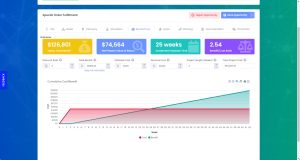 The opportunity pipeline in Automation Compass can also be used to track ongoing metrics, like how much the process has saved you since its inception.
The opportunity pipeline in Automation Compass can also be used to track ongoing metrics, like how much the process has saved you since its inception.
Never stop improving, but also never stop measuring. Take the time to celebrate your successes (or learn from the setbacks).
»Start your Automation Compass Journey Today!
Brian McKnight once said (sang rather), “if ever I believe my work is done, then I start back at one.”
For the same reason, the Griswolds couldn’t just go to Wally World. We can’t just stop improving our processes after a single project. We’ve got to go to Europe, Las Vegas, Christmas with the in-laws, Christmas on an island, and as many other places as we possibly can while the franchise is still doing well at the box office.
Process improvement never ends. If you aren’t always looking for ways to improve more things, your competition surely is. Don’t think of it as a Sisyphean task; think of it as building a good habit – like exercising. You don’t want your competition to have bigger biceps than you.
If you go to the gym and do 45 minutes of cardio each day, that’s great! If you go to the gym and do 45 minutes of cardio each year… fairly useless.
On the other hand, if you stick to the plan and develop those habits, you will see results. As Brian McKnight also said, “it’s undeniable.”
These are all metrics from actual projects.
Following these steps, we can do remarkable things. It all starts with a map.
Salient Process is a full-service digital business automation shop and proud IBM Automation business partner. To learn more about us at our website, request a free consultation with one of our expert automation advisors! We look forward to guiding you and your company along your own unique Digital Business Automation journey.